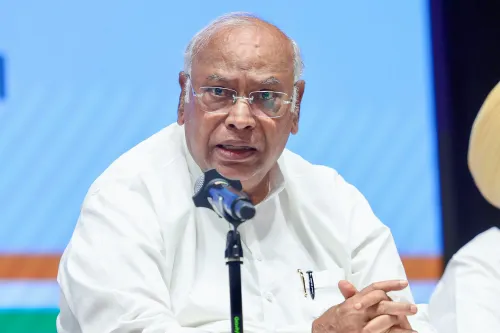Why is the 6th Round of India-US Negotiations on August 25 Significant?

Synopsis
Key Takeaways
- The sixth round of negotiations is on August 25.
- Trump's tariffs raise total tariffs to 50%.
- 67% of India's exports to the US are affected.
- Potential GDP impact could be significant.
- The RBI may consider further rate cuts.
New Delhi, Aug 7 (NationPress) The sixth round of negotiations between India and the US, aimed at achieving an interim trade agreement, is set for August 25. This session is particularly crucial following US President Donald Trump's announcement of an additional 25 percent tariffs on India, which raises the total tariffs to 50 percent, effective from August 27, according to a recent report by Morgan Stanley.
The report emphasizes that it will closely monitor export growth and domestic demand data for any potential spillover impacts, alongside any incremental policy responses.
In FY25, India's total exports to the US reached $86.5 billion, representing 2.2 percent of GDP. The original 25 percent tariff and the new penalty apply to 67 percent of India's exports to the US, equating to $58 billion or 1.5 percent of GDP (the remaining sectors are covered under section 232).
To evaluate the tariffs' effect on India's GDP, we apply insights from the input-output model developed by our global team.
If all goods exports incur a 50 percent tariff rate, the direct effect on growth could be 60 basis points, with an indirect impact potentially equal over a 12-month period.
Our sensitivity analysis for the 67 percent of non-exempted goods indicates a direct effect of 40 basis points and a comparable indirect effect, bringing the total impact to 80 basis points, as outlined in the report.
This sensitivity analysis reflects a linear impact based on shocks from external demand, without factoring in mitigating elements like domestic policy responses or market diversification.
“Regarding monetary policy, we expect the RBI to pursue further rate cuts, potentially implementing two additional reductions of 25 basis points each, in addition to the 25 basis points cut already anticipated in our base case. Furthermore, the central government is likely to pause its fiscal consolidation and may increase capital spending to bolster domestic demand,” the report stated.
“We will closely observe geopolitical developments and high-frequency growth indicators. The upcoming sixth round of negotiations between India and the US, scheduled for August 25, is crucial to monitor. We will keep an eye on export growth and domestic demand data for spillover effects, along with any incremental policy responses,” it concluded.









